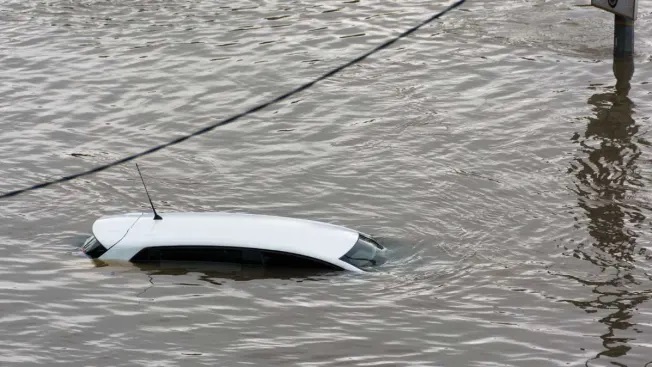By Consumer Reports
Cars swamped in stormwater could return to market far away from the hurricane zone.
Thousands of cars are damaged or destroyed by floods every year, but don’t assume all those vehicles end up in a junkyard.
Some are repaired and resold in other parts of the country without the buyer being aware of the car’s waterlogged history. In fact, Carfax says were 378,000 flooded cars were back on the roads in 2021, and Hurricane Ian is certain to see many more damaged cars added to the high-demand used-car market.
The key takeaway is that you need to be vigilant when buying a used car, even if you don’t live near a traditional storm area. That’s because flood-damaged cars are often transported well beyond their original region after major storms to locations where consumers may be less aware of the warning signs to look for.
Water can ruin electronics, lubricants, and mechanical systems. It may take months or years, but corrosion can find its way to the car’s vital electronics, including airbag controllers. Consumers need to carefully inspect any used car before buying one (or pay a mechanic to do it).
Consumer Reports’ chief mechanic, John Ibbotson, says to avoid vehicles with signs of deep-water exposure “even if a vehicle looks acceptable and may be working when you inspect it.” That’s because the long-term effects of water damage can haunt buyers for the life of the car.
Too often, when an insurance company declares a flood-damaged car a total loss, that information isn’t communicated to potential buyers. Once a flood car is totaled, it’s supposed to get a new title, called a salvage title. Those titles are usually plainly marked (known as being “branded”) with the word “salvage” or “flood.” In some states, this warning is shown on the title as an obscure letter or number code.
Totaled cars are typically sold at a salvage auction to junkyards and vehicle rebuilders. Reselling them to consumers may be legal if the flood damage is disclosed on the title. Those “salvage title” cars can’t be registered until necessary repairs are made and the vehicle is reinspected by officials. Then the vehicle is given a “rebuilt” title, which allows it to be registered for consumer use.
But as Consumer Reports found years ago in an investigation of rebuilt wrecks, some flood-damaged vehicles reappear with a clean title. Be especially wary of any used car being offered with a “lost” title or with only a bill of sale.

Water can get into a car's electrical system, causing more damage than may be visible on an initial inspection. Photo: Consumer Reports
One useful online tool for car shoppers is the National Motor Vehicle Title Information System, which helps consumers run background checks. This system aims to crack down on the practice of “title washing,” when cars that have been totaled (or stolen) get clean new titles in states with lax regulations.
However, if the vehicle’s owner didn’t have comprehensive insurance coverage at the time of the flooding or the repair bill didn’t exceed a certain level, the vehicle might not get a salvage or branded title at all. Only a few states offer a “flood” title, which requires a history of any flood damage.
Carfax offers a free flood damage check in addition to the vehicle history reports it sells. These checks show the “possibility of flood damage” based on area history and the registered address for the car at the time, and whether the vehicle’s title shows a reported flood history.
For a basic check, the National Insurance Crime Bureau offers VINCheck, a free service that searches vehicle identification numbers, although it doesn’t use as many data sources as some paid providers do.
Of course, vehicle history reports are not all-inclusive and are no guarantee that a vehicle is problem-free, but they’re a valued aid in screening potential cars. Ultimately, a detailed inspection is a consumer’s best protection.

Chasing the gremlins caused by water damage can be an extensive and expensive process. Photo: Consumer Reports
How to Spot a Flood-Damaged Car
Water damage can be hard to detect, but Consumer Reports says you should look for some telltale signs.
- Inspect the carpets to see whether they show signs of having been waterlogged, such as smelling musty or having caked-on mud. Brand-new carpets in an older vehicle may be another red flag.
- Check the seat-mounting screws to see whether there’s any evidence that they were removed. To dry the carpets effectively, the seats must be removed and possibly even replaced.
- Inspect the lights. A visible waterline may still show on the lens or reflector.
- Inspect the difficult-to-clean places, such as gaps between panels in the trunk and under the hood, for mud and debris.
- Look on the bottom edges of brackets or panels, where grime wouldn’t settle usually.
- Look at the heads of any unpainted, exposed screws under the dashboard. Bare metal will show signs of rust in flooded cars.
- Check to see whether the rubber drain plugs under the car and on the bottom of doors look as if they have been removed recently. That may have been done to drain floodwater.
If you’re from an area affected by a flood and have a car that wasn’t damaged, be aware that buyers might suspect it was. Have a mechanic inspect your car before you put it up for sale so that you can present potential buyers with a clean bill of health.
Original Source:

